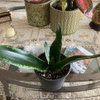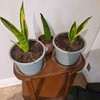I've seen a couple of people post here about seeing plants in sad condition (usually at one of the home improvement chains), and feeling sad, and 'rescuing' the plant. I have a couple of comments to make - these are just my opinion, so everybody stay calm.
I think it is a terrible mistake to 'rescue' a common variety that is in poor condition, especially if you pay more than $1). Sansevieria are tough plants, and leaf damage and scars aren't what I'm talking about here - I'm talking about the plant that has been shoved in the corner, in the dark, overwatered, and in prety bad shape. The posts I've read imply that these are the plants that people are speaking about. Now, I've tried my luck with a couple of these poor condition plants (when they were rare species I couldn't otherwise get), and while it is possible to 'save' a plant, more often than not I introduced problems wo my other plants. Most of the insect infestations, general rot, and fungus problems I've had have come from these 'rescued' plants, and some have killed some previously healthy plants in my collection.
Now, I don't want to sound like a snob, but I'd rather save my pennies and get a healthy plant than get a 'bargain' that will cause real problems for me. As I've said, I've done this for some variegated species that normally sell for $100 or more, but the bargain was really one I couldn't pass up - $5 to $10.
Amyone who saves S. trifasciata, tri. futura, hanii, tri. 'Moonshine', or any other commonly available and inexpensive savsevieria that has serious problems should think twice, and then pass up the offer - even if the plant is free. I'm sure there are plenty of people here in this group who would be happy to share healthy starts with you - when the weather warms up, and if you post in the EXCHANGES section.
I know too many beginners (with Sansevieria, Orchids, Hoya, Cactus, etc) who want the bargain, and are terribly dissapointed when their plants always look terrible, are unhealthy, and the problems spread to other plants in their collections. To these people, I advise that it is not a sin to throw out disease or problem plants, and to give away plants that you cannot grow.
I had traveled to Thailand a couple of years ago, and brought back (legally) a number of 'Crown of Thorn' hybrids that are like nothing available her in the states. It became apparent after one year that I did not have enough light to grow these wonderful plants, so I gave them away to friends. It was a painful (and expensive) experience, but the plant slook great in their new homes - something I would NEVER have been able to accomplish in my growing area. I learned my limitation (not enough light), and moved on to other plants that I CAN grow well.
Joe 'off my soapbox' DeRosa










kniphofia
joshc
Related Professionals
Danbury Landscape Architects & Landscape Designers · Cottonwood Landscape Architects & Landscape Designers · Ferndale Landscape Architects & Landscape Designers · Burlington Landscape Contractors · Goodyear Landscape Contractors · Ashburn Landscape Contractors · Fort Payne Landscape Contractors · Lemoore Landscape Contractors · Mendota Heights Landscape Contractors · Norwalk Landscape Contractors · St. Louis Landscape Contractors · Kingsburg Landscape Contractors · Wichita Window Contractors · Plainview Window Contractors · The Villages Window ContractorsjderosaOriginal Author
elsier
theobjr